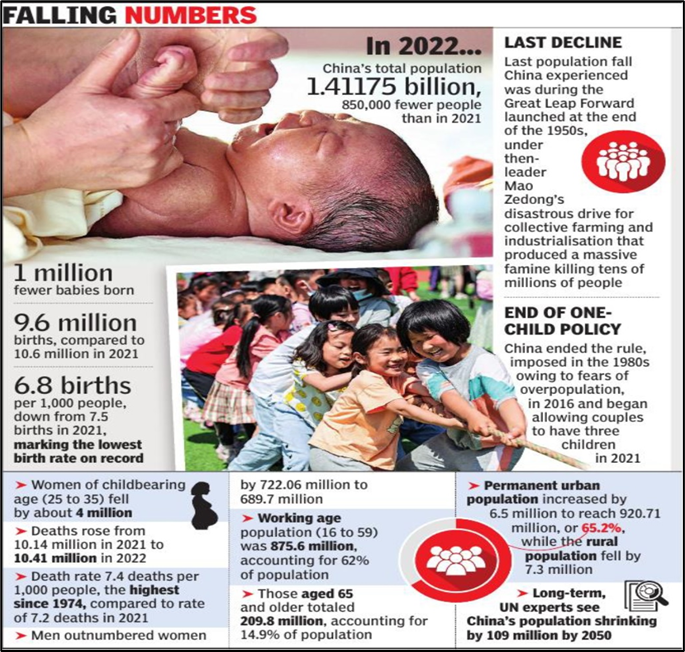ForumIAS announcing GS Foundation Program for UPSC CSE 2025-26 from 19 April. Click Here for more information.
ForumIAS Answer Writing Focus Group (AWFG) for Mains 2024 commencing from 24th June 2024. The Entrance Test for the program will be held on 28th April 2024 at 9 AM. To know more about the program visit: https://forumias.com/blog/awfg2024
Contents
Source: The post is based on the article “In a landmark shift, China’s population declines in 2022” published in The Hindu on 17th January 2023.
What is the News?
China’s population has decreased for the first time in more than 60 years.
About China’s Declining Population

According to data published by the National Bureau of Statistics of China, the population of mainland China was 1.411 billion people at the end of 2022, a decrease of 850,000 over the previous year.
The number of births in China was 9.56 million, a more than 10% drop from 2021. The number of deaths was 10.41 million.
These new figures mark the first fall in China’s population since 1961 when the country battled the worst famine in its modern history, caused by Mao Zedong’s disastrous agricultural policy known as the Great Leap Forward.
Why is China’s population declining?
China’s fertility rates were already decreasing in the 1970s and by 1980 the Chinese government formally instituted the controversial one-child policy, legally restricting families from having more than one baby.
The policy was intended to further limit China’s population growth and help stimulate an economic boom. Ultimately it resulted in low fertility rates and a large ageing population.
In 2015, China ended the one-child policy and began allowing married couples to have two children. It expanded the allowance again in 2021, permitting up to three kids.
However, the government’s efforts to boost birth rates have failed to reverse the trend. A survey carried out at the time of the introduction of the two-child policy found 70% of respondents cited financial reasons, including costs of education, healthcare and housing for not having many children.
Hence, these current trends reflect changing social values in China as families choose to have fewer children.
What will be the impact of this on China?
The real crisis for China is the decline in its population that is of prime working age. The share of China’s working-age population is projected to fall below 50% by 2045.
Where does India stand?
India has not conducted an official headcount Census since 2011.
But going by the United Nations’ projections, its population stood at 1,417.2 million in 2022 (more than China’s) and is expected to reach 1,428.6 million in 2023.
How can India utilize this opportunity?
India has just begun seeing fertility rates fall to replacement levels, including in rural areas. But even with the fertility rate declines, India’s population is projected to expand and de-grow only after touching 1.7 billion about 40 years from now.
More importantly, the share of the working-age population in the overall population crossed 50% only in 2007 and will peak at 57% towards the mid-2030s.
However, this is entirely contingent upon the creation of meaningful employment opportunities for a young population. In the absence of which, the demographic dividend can well turn into a demographic nightmare.




